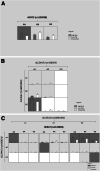Skin pigmentation polymorphisms associated with increased risk of melanoma in a case-control sample from southern Brazil
- PMID: 33167923
- PMCID: PMC7650158
- DOI: 10.1186/s12885-020-07485-x
Skin pigmentation polymorphisms associated with increased risk of melanoma in a case-control sample from southern Brazil
Abstract
Background: Melanoma is the most aggressive type of skin cancer and is associated with environmental and genetic risk factors. It originates in melanocytes, the pigment-producing cells. Single nucleotide polymorphisms (SNPs) in pigmentation genes have been described in melanoma risk modulation, but knowledge in the field is still limited.
Methods: In a case-control approach (107 cases and 119 controls), we investigated the effect of four pigmentation gene SNPs (TYR rs1126809, HERC2 rs1129038, SLC24A5 rs1426654, and SLC45A2 rs16891982) on melanoma risk in individuals from southern Brazil using a multivariate logistic regression model and multifactor dimensionality reduction (MDR) analysis.
Results: Two SNPs were associated with an increased risk of melanoma in a dominant model: rs1129038AA and rs1426654AA [OR = 2.094 (95% CI: 1.106-3.966), P = 2.3 10- 2 and OR = 7.126 (95% CI: 1.873-27.110), P = 4.0 10- 3, respectively]. SNP rs16891982CC was associated with a lower risk to melanoma development in a log-additive model when the allele C was inherited [OR = 0.081 (95% CI: 0.008-0.782), P = 3 10- 2]. In addition, MDR analysis showed that the combination of the rs1426654AA and rs16891982GG genotypes was associated with a higher risk for melanoma (P = 3 10- 3), with a redundant effect.
Conclusions: These results contribute to the current knowledge and indicate that epistatic interaction of these SNPs, with an additive or correlational effect, may be involved in modulating the risk of melanoma in individuals from a geographic region with a high incidence of the disease.
Keywords: Melanoma; Pigmentation; SNPs.
Conflict of interest statement
The authors declare that they have no competing interests.
Figures


Similar articles
-
Analysis of Skin Pigmentation and Genetic Ancestry in Three Subpopulations from Pakistan: Punjabi, Pashtun, and Baloch.Genes (Basel). 2021 May 13;12(5):733. doi: 10.3390/genes12050733. Genes (Basel). 2021. PMID: 34068188 Free PMC article.
-
Genetic variants in pigmentation genes, pigmentary phenotypes, and risk of skin cancer in Caucasians.Int J Cancer. 2009 Aug 15;125(4):909-17. doi: 10.1002/ijc.24327. Int J Cancer. 2009. PMID: 19384953 Free PMC article. Clinical Trial.
-
Simultaneous Genotyping of Three Nonsynonymous SNVs, rs1042602, rs1426654, and rs16891982 Involved in Skin Pigmentation by Fluorescent Probe-Based Melting Curve Analysis.Hum Mutat. 2025 Jul 23;2025:3468799. doi: 10.1155/humu/3468799. eCollection 2025. Hum Mutat. 2025. PMID: 40741336 Free PMC article.
-
Skin Pigmentation Genetics for the Clinic.Dermatology. 2017;233(1):1-15. doi: 10.1159/000468538. Epub 2017 May 3. Dermatology. 2017. PMID: 28463841 Review.
-
Comprehensive field synopsis and systematic meta-analyses of genetic association studies in cutaneous melanoma.J Natl Cancer Inst. 2011 Aug 17;103(16):1227-35. doi: 10.1093/jnci/djr219. Epub 2011 Jun 21. J Natl Cancer Inst. 2011. PMID: 21693730 Free PMC article. Review.
Cited by
-
Skin pigmentation related variants in Mexican population and interaction effects on serum 25(OH)D concentration and vitamin D deficiency.Sci Rep. 2024 Jul 29;14(1):17378. doi: 10.1038/s41598-024-68437-0. Sci Rep. 2024. PMID: 39075179 Free PMC article.
-
Estimation of genetic variation in vitiligo associated genes: Population genomics perspective.BMC Genom Data. 2024 Jul 26;25(1):72. doi: 10.1186/s12863-024-01254-6. BMC Genom Data. 2024. PMID: 39060965 Free PMC article.
-
Melanoma susceptibility: an update on genetic and epigenetic findings.Int J Mol Epidemiol Genet. 2021 Oct 15;12(5):71-89. eCollection 2021. Int J Mol Epidemiol Genet. 2021. PMID: 34853632 Free PMC article. Review.
-
In silico analysis of the solute carrier (SLC) family in cancer indicates a link among DNA methylation, metabolic adaptation, drug response, and immune reactivity.Front Pharmacol. 2023 Jun 15;14:1191262. doi: 10.3389/fphar.2023.1191262. eCollection 2023. Front Pharmacol. 2023. PMID: 37397501 Free PMC article.
-
Association of pigmentation related-genes polymorphisms and geographic environmental variables in the Chinese population.Hereditas. 2021 Jul 8;158(1):24. doi: 10.1186/s41065-021-00189-7. Hereditas. 2021. PMID: 34238381 Free PMC article.
References
-
- Chang YM, Barrett JH, Bishop DT, Armstrong BK, Bataille V, Bergman W, Berwick M, Bracci PM, Elwood JM, Ernstoff MS, et al. Sun exposure and melanoma risk at different latitudes: a pooled analysis of 5700 cases and 7216 controls. Int J Epidemiol. 2009;38(3):814–830. doi: 10.1093/ije/dyp166. - DOI - PMC - PubMed
-
- Lian CG. Jr Mihm MC: Skin Cancer. In: BWSaCP W, editor. World Cancer Report 2014, vol. 2014. Lyon Cedex: International Agency for Research on Cancer. p. 495–502.
-
- Ferlay J, Ervik M, Lam F, Colombet M, Mery L, Piñeros M, Znaor A, Soerjomataram I, Bray F. Global Cancer observatory: Cancer today. Lyon: International Agency for Research on Cancer; 2018.
MeSH terms
Substances
Grants and funding
LinkOut - more resources
Full Text Sources
Medical

